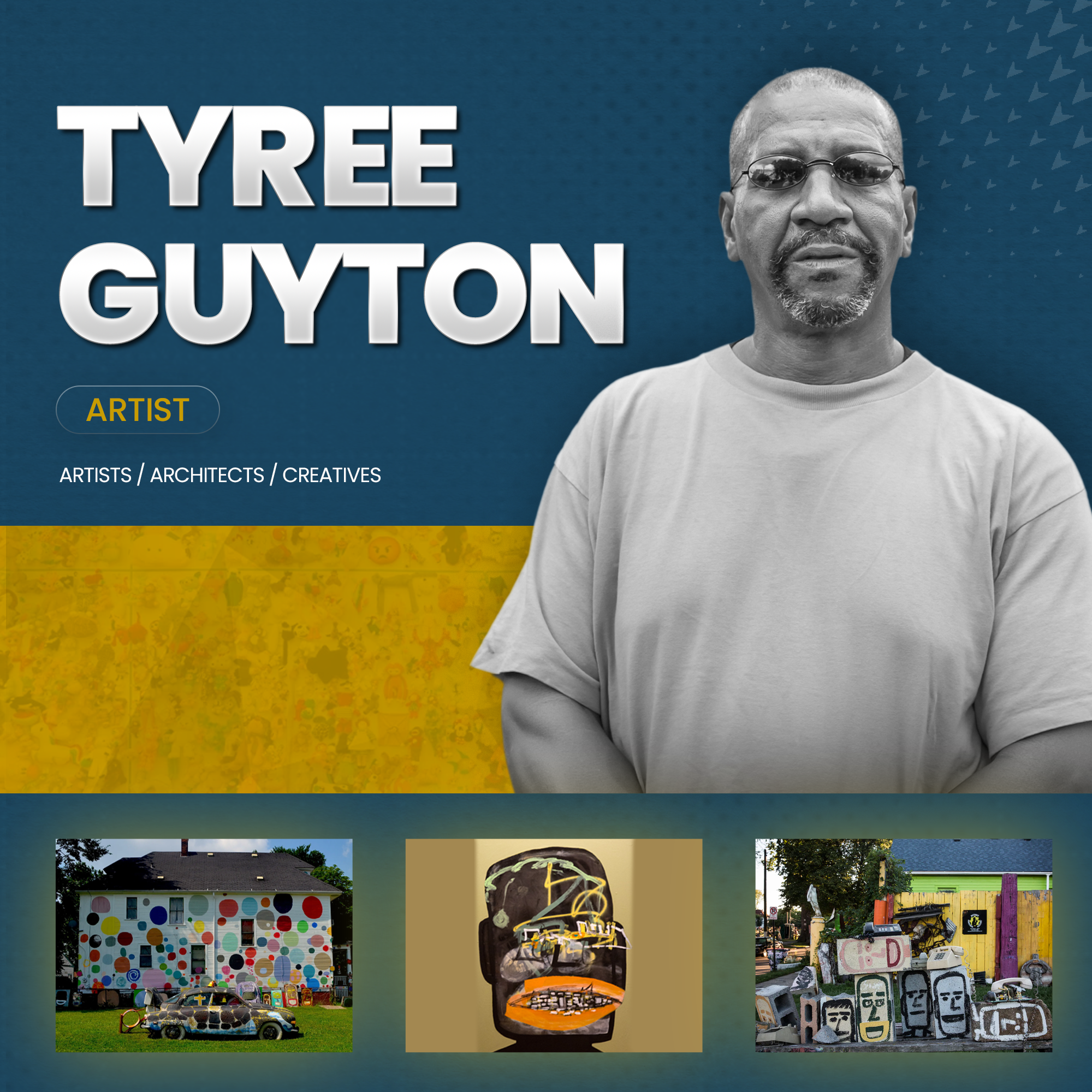Born: 24 August 1955 – Detroit, Michigan
Detroit Era: 1955-present
Legacy: Creator of the Heidelberg Project, an internationally acclaimed urban artist who sees public art as healing, protest, and social reclamation
In a city of factories, foreclosures, and forgotten corners, Tyree Guyton did the unthinkable: He walked away from the 9-to-5 grind, grabbed a paintbrush, and created a gallery in the midst of wasteland.
In abandoned homes, he painted faces.
He stuck shoes to walls, hung dolls from trees, and polka-dotted up an entire block of homes.
Some called it madness.
Others genius.
But no one could deny that it was quintessentially Detroit – raw, revived, and uncompromising.
The Ashes of the East Side
Tyree Guyton was raised on Detroit’s Heidelberg Street – the neighborhood that would become synonymous with urban decay.
The 1967 riots, which some would call an uprising, ruined his childhood and his faith in authority.
By the 1980s, Guyton had been in the military, worked at an auto plant, driven trucks, and studied art with Charles McGee at the College for Creative Studies.
What he never could have anticipated was that those would be the very same years he witnessed his childhood street turn into a strip of empty houses, trash, and violence.
His response?
He didn’t wait for grants.
He didn’t ask for permission.
He simply picked up a paintbrush and began fighting the blight all on his own.
The Heidelberg Project Begins
Guyton started the Heidelberg Project with his grandfather Sam Mackey, also known as “Grandpa Sam.”
They began cleaning up lots, painting polka dots on rundown homes, and installing found-object sculptures made from shoes, shopping carts, TVs, baby dolls, and other discarded toys.
It was grotesque.
Beautiful.
Sacred.
A junkyard cathedral for the people by the people.
Each object told a story:
Dolls without limbs: What happens when a society forgets its children?
Houses covered in clocks: Time is running out for Detroit.
Shoes nailed to homes: Journeys ended or cut short.
It was protest art.
Healing art.
And it came as a cry from the ruins.
It also turned Tyree Guyton into both a legend and a target.
Battles with the City
City officials were less impressed.
To them, Tyree’s work was urban blight with face paint.
Between 1989 and 1999, the City of Detroit destroyed several Heidelberg homes, including Guyon’s installations.
Bulldozers came in without warning, and just like that, years of work were gone in an instant.
Yet Guyton never stopped.
He rebuilt it again and again, refusing to let bureaucracy erase what his community needed to say.
He once said:
“The real crime is what they let this neighborhood become. I’m just showing it.”
The International Response to Guyton’s Art
When local officials tried to flatten the project, the world watched.
The Heidelberg Project appeared in:
- The New York Times
- Time Magazine
- PBS and BBC documentaries
- Exhibits throughout South Africa, Switzerland, France, and Italy.
Guyton also served as a keynote speaker at the Society for Photographic Education’s 55th Annual Conference in 2018, underscoring his prominence in the art and academic communities and proving that what once started as a rage-fueled art project quickly turned into a global case study of creative resistance.
Healing Through Art
For Guyton, though, it was always about Detroit.
His work is rooted in childhood loss, displaced families, and communities shattered by racism, redlining, and generational neglect.
He used the Heidelberg Project to stir dialogue, joy, confusion, discomfort, and whatever else it took to get people awake.
And it worked.
He lit the torch for generations of Detroit artists – from Sheefy McFly to Sydney G. James to Tiff Massey and countless others.
Then, in 2016, Guyton announced “Heidelberg 3.0,” a 10-year plan to take the project beyond installation to sustainable community development through cultural programming, artist residencies, and economic revitalization.
Final Word: The Prophet in Polka Dots
No, Tyree Guyton did not rebuild Detroit with bricks or bills.
He rebuilt it with meaning.
He turned wreckage into beauty.
He made the forgotten memorable.
Where most people saw trash, he saw testimony – and a soul where others saw an eyesore.
He did not merely paint houses – he painted hope.
Take a stroll down Heidelberg Street today and you’ll hear it yourself if you listen hard enough:
The sound of a city clawing its way back.
